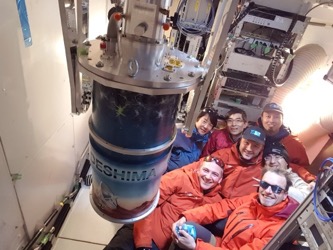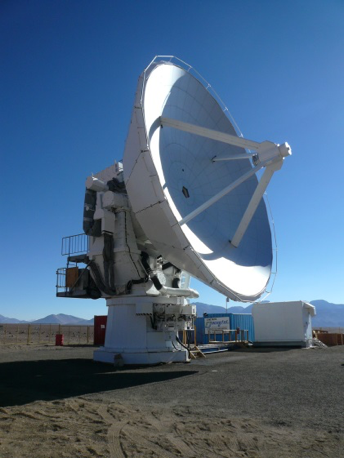DESHIMA is a completely new type of astronomical instrument with which a 3D map of the early universe can be constructed. In early October, Dutch and Japanese researchers installed the DESHIMA measurement instrument under the ASTE telescope in Chile. Over the past few days, DESHIMA has recorded light from an astronomical source for the first time. The development represents a significant milestone in the process of making the instrument operational. (Dutch follows English).
DESHIMA has been developed by TU Delft, SRON Netherlands Institute for Space Research and the Leiden Observatory, working together with a consortium of Japanese universities led by The University of Tokyo, and the National Astronomical Observatory of Japan (NAOJ).
Early beginnings
Astronomers looking to find out more about the early beginnings of our universe need to measure infrared light which has taken between 10 and 13 billion years to reach earth. Sensitive instruments are required for this. A team from TU Delft is collaborating with SRON, Leiden Observatory and Japanese astronomers to develop superconductive and extremely sensitive measurement equipment that speeds up the current measurement process 100-fold. Its members are currently on location in Chile to install and test the equipment.

A new type of spectrometer
The research team departed in September for the Atacama Desert in Chile. There, at an altitude of 4.8 kilometres, you will find the Japanese Atacama Submillimeter Telescope Experiment (ASTE). During recent weeks, DESHIMA (Deep Spectroscopic High-redshift Mapper) was installed into this telescope. This new type of spectrometer determines the exact distance to far infrared star systems by measuring the ‘redshift’ of the spectrum of the star systems. DESHIMA is the first broadband spectrometer for these specific infrared frequencies.

Great precision
The idea for DESHIMA was born in 2009, at the same place in Chile. That was when Akira Endo (TU Delft) came up with the concept of a spectrometer with a large number of MKID detectors. MKIDs, or Microwave Kinetic Inductance Detectors, are extremely sensitive radiation detectors that can detect the most minute changes in radiation energy with the greatest precision. Jochem Baselmans (SRON/TU Delft) later suggested creating the entire spectrometer on the same chip, without using optics: the idea of the superconductive, on-chip spectrometer was born.
A single superconductive chip, further developed by these and other researchers from TU Delft and SRON, collects the far infrared radiation, filters it into narrower frequencies and detects the luminosity per frequency. The chip is cooled in a cryostat (developed by Entropy) to a temperature of -273 degrees Celsius (120 milliKelvin) and read by special reading electronics. The cryogenic measurement setup and electronics were both developed by SRON.
Proof of principle
Narrowband far infrared spectrometers are already available, but DESHIMA is the first spectrometer of its kind to actually be tested on a telescope. What makes DESHIMA special is its instantaneous bandwidth: DESHIMA will be tested in Chile as proof of principle at a frequency of 346 Gigahertz and an instantaneous bandwidth of 40 Gigahertz. Nobody has ever attempted to use such a large bandwidth to look so far back in time and deep into space.
The aim is to work towards a bandwidth of 240-720 GHz in a few years’ time, which requires even more precise – and hence more challenging – lithography. SRON and TU Delft are already working on a successor to DESHIMA called MOSAIC, a 25-pixel version that is expected to be operational in three years’ time.
If everything goes according to plan, researchers will soon be able to use it to create the first 3D map of star systems dating back to the dawn of our universe.
More information
In the DESHIMA project, TU Delft collaborates closely with the SRON Netherlands Institute for Space Research, Leiden Observatory, the University of Tokyo, Nagoya University, The University of Electro-Communications, Saitama University, Hokkaido University, and the National Astronomical Observatory of Japan (NAOJ). This research was made possible with grants of NWO, ERC and JSPS.
The Atacama Submillimeter Telescope Experiment (ASTE) is the state-of-the-art 10-m submillimeter telescope located 4,800 meters above sea level at the Atacama Desert in Northern Chile. NAOJ operates ASTE in collaboration with Japanese universities and the University of Chile. ASTE is a forefront observatory of the cool universe and at the same time, provides a testbed environment for cutting-edge technologies for advancing astronomy. http://alma.mtk.nao.ac.jp/aste/index_e.html
To find out more about the technology behind DESHIMA, the research project in Chile and studying star systems in general, read the blog produced by TU Delft’s Faculty of Electrical Engineering, Mathematics and Computer Science:
https://www.tudelft.nl/en/eemcs/current/nodes/stories/the-deshima-guide-to-the-galaxy/
For more information or for interviews with the researchers:
Roy Meijer, TU Delft Science Information Officer, +31 15 278 1751
Renske van den Berg, SRON Netherlands Institute for Space Research, Communication & Media Relations, +31 88 777 5893
DESHIMA ziet first light: cartografie van de verste sterrenstelsels stap dichterbij
Het DESHIMA-instrument is een compleet nieuw type astronomisch instrument waarmee een 3D-kaart van het vroege heelal gemaakt kan worden. Begin oktober hebben Nederlandse en Japanse onderzoekers het meetinstrument gemonteerd in de ASTE-telescoop in Chili. DESHIMA heeft de afgelopen dagen voor het eerst licht gemeten, het zogenaamde ‘first light’ in vaktermen, een belangrijke mijlpaal bij het in gebruik nemen van het instrument.
DESHIMA is ontwikkeld door TU Delft, SRON Netherlands Institute for Space Research en de Leidse sterrenwacht, samen met een consortium van Japanse universiteiten onder leiding van Tokyo University en NAOJ, de nationale sterrenwacht van Japan.
Prille begin
Als astronomen meer willen weten over het prille begin van ons heelal, moeten ze infrarood licht meten dat er tussen de 10 miljard en 13 miljard jaar over heeft gedaan om de aarde te bereiken. Daar zijn gevoelige instrumenten voor nodig. Een team van de TU Delft en SRON werkt samen met de Leidse sterrenwacht en Japanse astronomen aan supergeleidende en heel gevoelige meetapparatuur die het huidige meetproces met een factor honderd versnelt. Ze zijn op dit moment op locatie in Chili om alles te installeren en te testen.

Nieuw type spectrometer
Het onderzoeksteam vertrok in september naar de Atacama woestijn in Chili. Op 4,8 km hoogte staat daar de Japanse ASTE-telescoop (Atacama Submillimeter Telescope Experiment). Hierin werd de afgelopen weken DESHIMA (Deep Spectroscopic High-redshift Mapper) geïnstalleerd. Het nieuwe type spectrometer bepaalt de precieze afstand van zulke sterrenstelsels, door in het ver-infrarood spectrum van deze sterrenstelsels de zogenaamde roodverschuiving te meten. Vóór DESHIMA was er nog geen breedband spectrometer voor deze specifieke ver-infrarood frequenties.

Grote precisie
DESHIMA gebruikt Microwave Kinetic Inductance Detectoren (MKID) om de kleinst mogelijke verschillen in stralingsenergie met de grootste precisie op te merken. Het idee daarvoor begon in 2009 op dezelfde plek in Chili. Toen kreeg Akira Endo (TU Delft) het idee voor een spectrometer met een grote hoeveelheid MKIDs. Later stelde Jochem Baselmans (SRON/TU Delft) voor om de gehele spectrometer op een en dezelfde chip te maken, zonder gebruik van optica: het idee van de supergeleidende, on-chip spectrometer was geboren.
Eén supergeleidende chip, verder uitontwikkeld door onderzoekers van TU Delft en SRON, ontvangt de ver-infrarood straling, filtert die uiteen naar verschillende deelfrequenties en meet per frequentie de helderheid. De chip wordt gekoeld tot -273 graden Celsius (120 milliKelvin) door een cryostaat van Entropy, en uitgelezen met speciale uitleeselektronica. De cryogene meetopstelling en uitleeselektronica zijn beide bij SRON ontwikkeld.
Proof of principle
On-chip spectrometers bestaan al, maar DESHIMA is de eerste spectrometer in zijn soort die daadwerkelijk aan een telescoop wordt getest. DESHIMA is dan ook bijzonder vanwege zijn instantane bandbreedte: DESHIMA wordt in Chili als proof of principle getest op een frequentie van 346 Gigahertz en een bandbreedte van 40 Gigahertz. Het doel is om de komende jaren DESHIMA te verbeteren tot een bandbreedte van 240-720 GHz. En er wordt al gewerkt aan de opvolger van DESHIMA, MOSAIC, die meerdere on-chip spectrometers combineert in één instrument.
Als alles goed gaat, kunnen onderzoekers er binnenkort voor het eerst een driedimensionale kaart mee maken van sterrenstelsels uit de begintijd van het universum.
Meer informatie
In het DESHIMA project werkt de TU Delft nauw samen met SRON Netherlands Institute for Space Research, Leiden Observatory, de Universiteit van Tokyo, Nagoya University, The University of Electro-Communications, Saitama University, Hokkaido University, en de National Astronomical Observatory of Japan (NAOJ). DESHIMA is (mede) gefinancierd door NWO, ERC en JSPS.
Lees meer over de techniek achter DESHIMA, het onderzoek in Chili en sterrenstelsels bestuderen in het algemeen op de blog van de faculteit Elektrotechniek, Wiskunde en Informatica van de TU Delft:
https://www.tudelft.nl/ewi/actueel/nodes/stories/the-deshima-guide-to-the-galaxy/
Zie ook http://endolab.tudelft.nl/deshima/
Voor meer informatie of interviews met de onderzoekers:
Roy Meijer, Adviseur wetenschapscommunicatie TU Delft, 015-2781751
Renske van den Berg, SRON Netherlands Institute for Space Research, Communicatie & Mediarelaties, 088 777 5893


